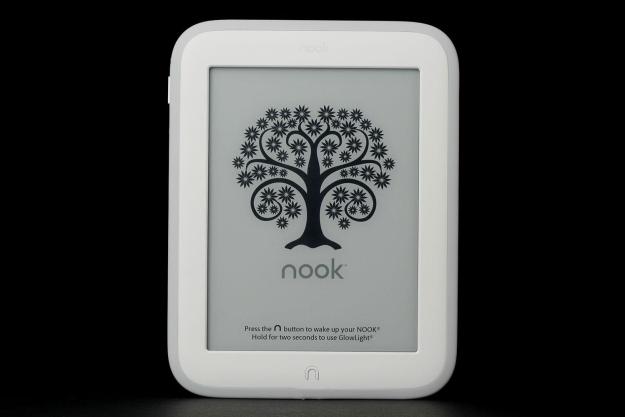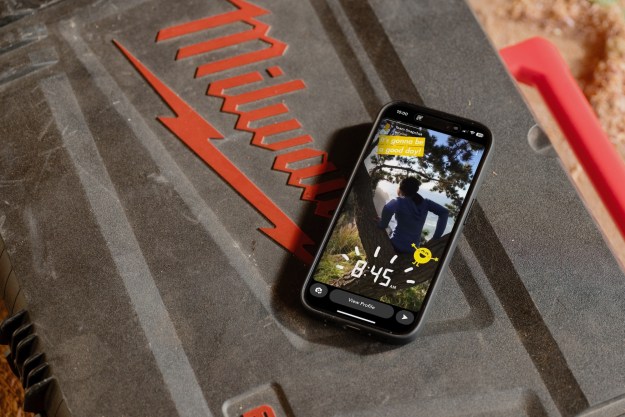
“The new Nook GlowLight has a better screen and brighter light, but that light is still uneven, its lack of page turn buttons make it difficult to use for lefties, and the overall package can’t match the Kindle Paperwhite.”
- Screen is more pixel dense with deeper contrast
- GlowLight is brighter
- Speedy, responsive performance
- No physical page turn buttons
- No improvements to the software or extras
- No MicroSD card slot
- Little space for non-B&N ebooks and files
- GlowLight still uneven
Until color E Ink finally fulfills its promise, little innovation may happen in the ebook reader space. The devices are finally speedy when it comes to navigating and turning pages, E Ink screens offer deep contrast and crisp fonts, touch is standard across all major manufacturers, and so is a built-in light. You get this for around $100. All that’s left is for the major players to refine their designs and maybe add more pixels to their displays.
That’s just what Barnes & Noble did with the new $120 Nook GlowLight. It’s slimmer and lighter than before, the display is sharper and more pixel dense, and the reader now lacks physical page turn buttons and a MicroSD card slot. This distilled approach makes the Nook look more like the competition, namely the Kindle Paperwhite and the Kobo Aura, thus making it feel like a “me too” device instead of an innovative one.
Should you stick with your Nook Simple Touch or spring for the new hotness?
Thinner, but those page turn buttons are gone
This generation Nook GlowLight is narrower and lighter because B&N eliminated the physical page turn buttons. We can appreciate wanting to make a reading device lighter, we’re just not sure it was necessary. The previous generation’s design was perfectly small, light, and holdable. It’s bigger than the Kindle Paperwhite, yes, but there’s learning from the competition and blindly following the same for no good reason.
Other than getting slimmer, the Nook underwent a few other notable changes. The color is now white and the surface no longer completely coated in a rubberesque, non-slip material. The only remnant of that is a soft-touch rim around the edge to maintain comfort while cradled in your palm. The size, shape, and weight mean the Nook is holdable and easy to balance.
We’re glad that the power button remains in an easily accessible spot and not awkwardly on the bottom like the Paperwhite. The ‘n’ button doubles as the Home and GlowLight on/off button and is more efficient than having the controls on-screen (and thus sometimes hidden).
A better E Ink screen and brighter light
Where we saw the most improvement between this generation and the last is the E Ink display. The 1024 x 768 resolution and 16 levels of grayscale produce sharp and crisp text with deep contrast against the background. It’s on a par with the Kindle, both in quality and in specs. The anti-glare coating on the display no longer makes text look washed out when the light isn’t on.
The first generation GlowLight caught two big criticisms that Barnes & Noble clearly took to heart: the uneven light distribution and that it wasn’t as bright as the Paperwhite light. The first critique is valid, though that unevenness wasn’t very noticeable or distracting. However, you don’t need a super bright light beaming into your eyes. A gentle light is enough, in our opinion.

Easy on the eyes, but hard to use if you’re a leftie
The crisp text and high contrast are great for reading, and we appreciate the multiple font options, text sizes, and control over line spacing and margins. You can’t go as deep into font weight and sharpness as you can on the Kobo Aura, but we didn’t find it necessary to do so on any of the books we read. With the GlowLight on, contrast and text crispness got even better to our eyes.
The loss of the physical page turn buttons makes the Nook harder to use if you’re a leftie.
The loss of the physical page turn buttons makes the Nook harder to use ambidextrously. When using the left hand you can’t just tap to turn, you have to try and reach the thumb over far enough to swipe. When Amazon dropped the physical buttons on the Kindle, the software engineers at least designed a page turn system that made tap to turn possible no matter which hand you held it in. You still have to lift the finger to tap the screen, which requires balancing the device – not so with physical buttons.
This puts more emphasis on the Nook’s touch functionality, driven by an infrared sensor array. The e-reader responded to taps and swipes quickly; when tapping we saw near perfect accuracy. When swiping with our left thumb the Nook had trouble interpreting the motion sometimes.
Performance was speedy overall, keep in mind that an E Ink device can’t respond as quickly as a tablet. Within it’s limitations the Nook performed well. The simple and streamlined interface also helped. When outside of a book we had no trouble navigating, finding our way around, or accessing the settings we needed.
Sharing and syncing work, but where’s the exporting?
Aside from just reading books, people like to highlight passages, add notes, look up words, and share their reading status. The Nook Friends internal social network isn’t as emphasized on the E Ink side as it is on the tablets; so sharing options are limited to Twitter and Facebook. You can still lend a book to friends via email or Facebook if they have a B&N account (or are willing to set one up).
We’re glad that notes and highlights now sync across all devices more reliably than before. We’re puzzled that Nook owners still can’t export their notes and highlights to a text file. Kindle has had this feature for years and Nook users have been loudly asking for it every forum they can find for almost as long. If B&N is going to chase after Amazon we’d rather they tackle this problem than remove page turn buttons. The ability to send files to the Nook a la Kindle WhisperSync would be useful as well.

EPub support is great, but what happened to the MicroSD?
The shopping experience on the Nook is decent for an E Ink device. B&N kept the layout of the shop simple and exploring the digital shelves is possible, if not as relaxing or enjoyable as doing so on a computer or in a physical bookstore. The search function is fast and allows readers to sort results in useful ways, unlike the Kindle’s E Ink storefront. Most people will do their discovery elsewhere; at least the storefront doesn’t hamper the purchasing process.
We’d like to see Barnes & Noble put in more work on the software side and fiddle less with the Nook’s hardware.
Since the Nook is compatible with EPub files you can load books from local libraries and some other ebook stores (Kobo, Sony, Google Books), so it’s possible to migrate a library here if you decide to leave another ecosystem. Just don’t count on keeping a ton of non-B&N books on your Nook. There’s no MicroSD card slot on this generation GlowLight and of the 4GB of space on board, 2.5GB are available for books and 2GB of that is reserved for B&N content. That leaves 500MB for other books.
On top of that, the process for getting library books on the Nook is still overcomplicated. This is partly due to systems the bookstore has no control over, yet other ebook reader makers have tried to smooth it out. Amazon’s system for getting library books is almost as simple as buying from the store. And Sony created a Public Library app for its Reader that eliminates some of the tedious steps involved. Since the Nook runs on a modified version of Android this should be possible to emulate or improve on.
Conclusion
Ever since the first Nook debuted in 2009 each generation has improved on the last. Even when Barnes & Noble radically changed the design, it was done for the better. And each innovation from touch to built-in lights have made new Nooks highly desirable to ebook lovers. That’s what makes this new Nook so disappointing. It’s not a bad device. We love the display and the light – two of the most important aspects of the ebook reading experience – but it’s just not a step forward.
There’s no point in following Amazon’s lead in hardware design unless you’re also going to make the necessary software changes. We’d like to see Barnes & Noble put in more work on the software side and fiddle less with the Nook’s hardware, which already worked fine.
Right now, we recommend the Nook Simple Touch over the new GlowLight. If you need the built-in light, the new Kindle Paperwhite is an attractive choice.
Highs
- Screen is more pixel dense with deeper contrast
- GlowLight is brighter
- Speedy, responsive performance
Lows
- No physical page turn buttons
- No improvements to the software or extras
- No MicroSD card slot
- Little space for non-B&N ebooks and files
- GlowLight still uneven






